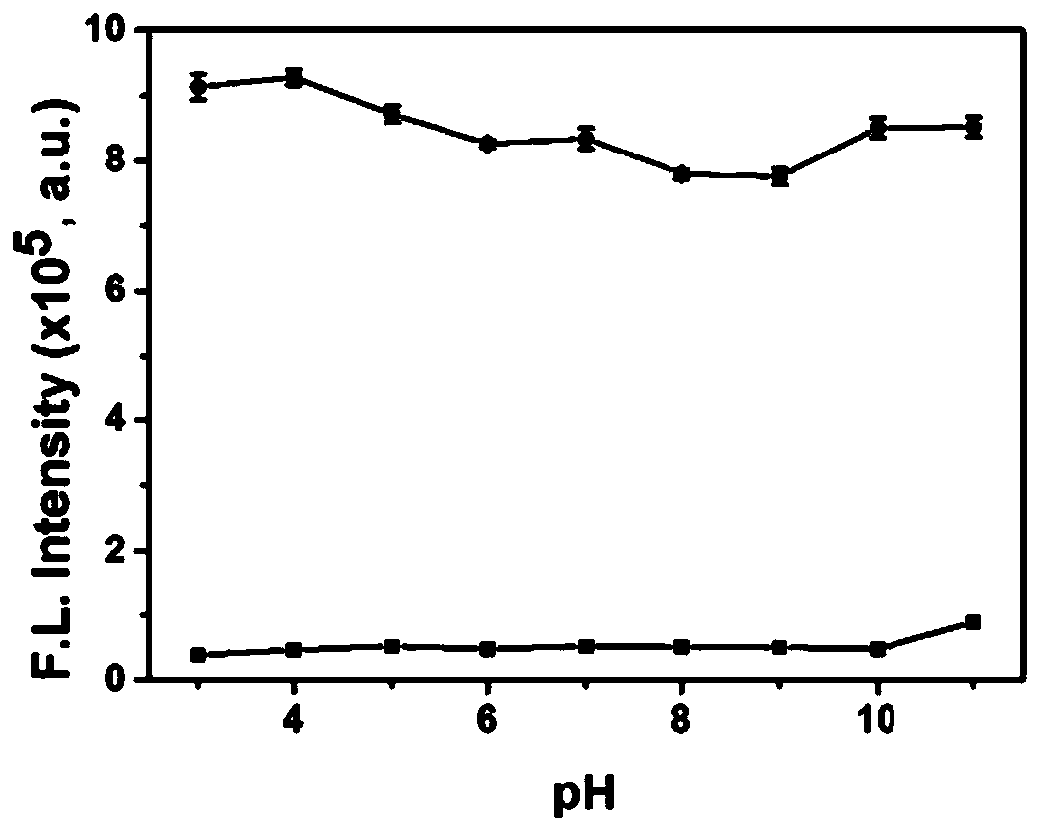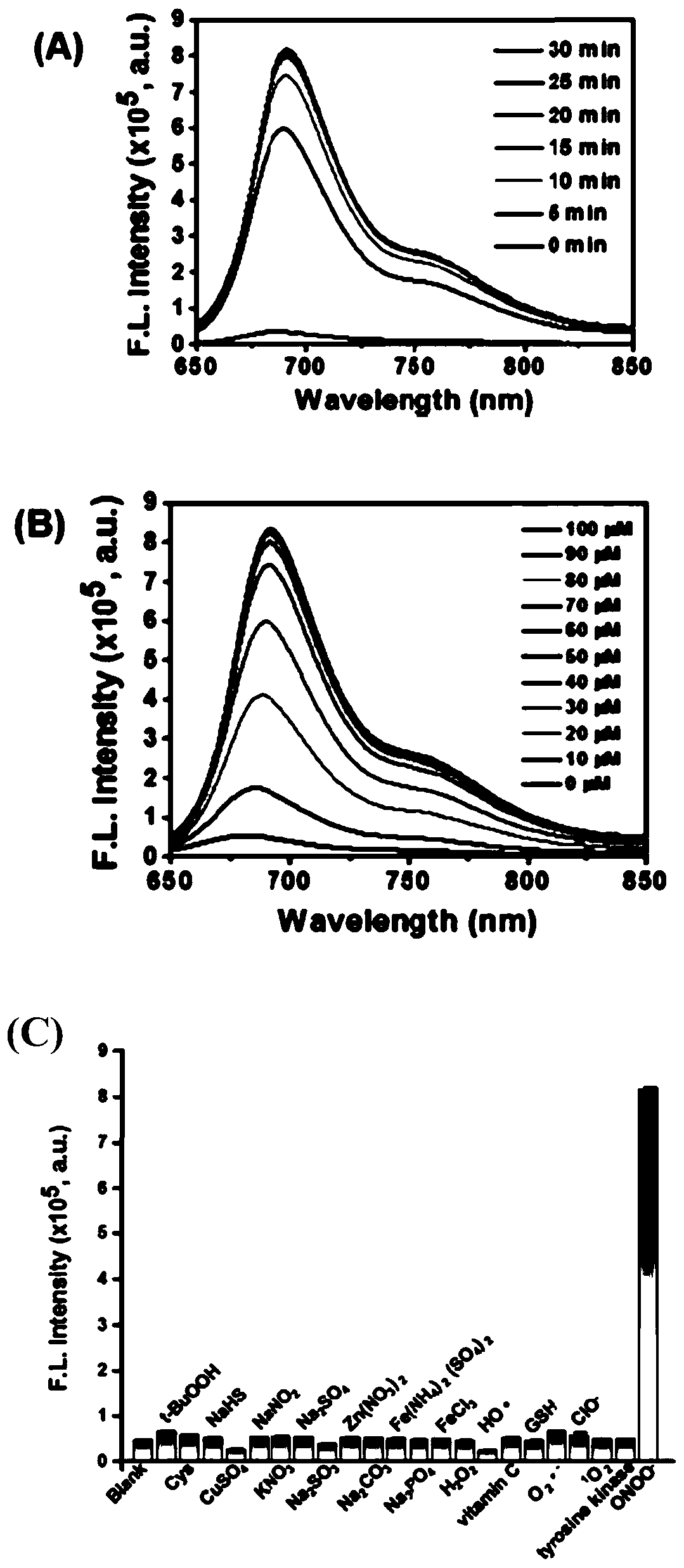Peroxynitrite near infrared fluorescent probe ONP and preparation method and application thereof
A peroxynitrite, a technology for peroxynitrite, applied in the field of biochemistry, can solve problems such as lack of in vivo imaging methods, and achieve the effects of high sensitivity, excellent concentration linear relationship, and good stability
- Summary
- Abstract
- Description
- Claims
- Application Information
AI Technical Summary
Problems solved by technology
Method used
Image
Examples
Embodiment 1
[0067] A kind of preparation method of near-infrared fluorescent probe ONP for peroxynitrite, its preparation process is as follows:
[0068]
[0069] Under argon protection, methylene blue (374mg, 1mmol), 10mL DCM and 10mL water were added to a 50mL round bottom flask, and stirred evenly. Na 2 S 2 o 4 (525mg, 1.5mmol) and NaHCO 3 (168mg, 2mmol) was slowly added to the above mixture. The mixture was then stirred for 20 minutes until the aqueous phase turned yellow. Aqueous layer The aqueous phase was extracted with dichloromethane (2 x 5 mL), and the organic layer was separated. The organic phases were combined and dried over anhydrous sodium sulfate. Under argon protection, the dry organic phase was quickly poured into a round bottom flask containing triethylamine (TEA, 170 μL, 1.2 mmol). 1 mL of DCM containing triphosgene (TPG, 120 mg, 0.32 mmol) was slowly added to the reaction mixture. After the addition was complete, the reaction was stirred at room temperature...
Embodiment 2
[0072] Synthesis and preliminary evaluation of ONP
[0073] The final structure of the near-infrared fluorescent probe ONP prepared in Example 1 is passed 1 H and 13 C NMR spectroscopy and mass spectroscopy fully confirmed. Then, preliminary in vitro tests were performed in PBS buffer (pH 7.4, 5% MeCN). ONP alone exhibits very weak UV absorption and fluorescence because the fluorescence of MB (methylene blue) is locked in the interrupted LMB form ( figure 1 B and C), however, it provides significant NIR excitation (640nm) and emission (650-850nm with a maximum at 692nm). Correspondingly, ONP (10 μ M, PBS buffer (pH7.4, 5% MeCN)) and ONOO - (100 μM, aqueous solution) after incubation at 37°C for 30 minutes, a significant increase in absorbance and fluorescence intensity at 665 nm and 692 nm, respectively, was observed. In order to study the stability and reliability of ONP to different pH conditions, the fluorescence changes in PBS buffer in different pH ranges (3-11) were...
Embodiment 3
[0075] ONP spectral properties and selectivity
[0076] To study ONP vs ONOO in more detail - The response of ONOO was evaluated by recording the change of fluorescence intensity at 692nm - Time-dependent fluorescence response in presence. Discover ONP and ONOO - The reaction between 10μM ONP and 100μM ONOO - at 5% CH 3 After co-incubating in CN's PBS system for 1 minute, a significant increase in fluorescence intensity can be clearly detected at 692 nm using a fluorescence spectrophotometer, and the reaction is completed within 15 minutes, ONOO - After activation, ONP is efficiently converted to MB ( image 3 A). Furthermore, when 10 μM ONP was combined with increasing concentrations of ONOO - (0-100μM) when incubated together, a concentration-dependent fluorescence enhancement was observed ( image 3 B), indicating that ONP is not only for ONOO - Fast response to low concentration of ONOO - Also highly sensitive, and the fluorescence intensity at 692 nm is comparab...
PUM
 Login to View More
Login to View More Abstract
Description
Claims
Application Information
 Login to View More
Login to View More - R&D
- Intellectual Property
- Life Sciences
- Materials
- Tech Scout
- Unparalleled Data Quality
- Higher Quality Content
- 60% Fewer Hallucinations
Browse by: Latest US Patents, China's latest patents, Technical Efficacy Thesaurus, Application Domain, Technology Topic, Popular Technical Reports.
© 2025 PatSnap. All rights reserved.Legal|Privacy policy|Modern Slavery Act Transparency Statement|Sitemap|About US| Contact US: help@patsnap.com



